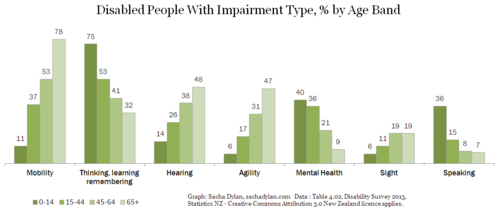A focused Disability Survey has been conducted after each national Census since 1996. This is the only official source of data about disabled New Zealanders. The first data from the 2013 Disability Survey has been released, focusing on demographic details. Later releases will add detail about needs and barriers.
A Million
The headline finding is that there are now over 1 million disabled people in New Zealand. That’s 24% or about one in four of the total population.
If we understand disability as the interaction between how a person functions and how the world functions, there will obviously be a great variety of combinations. They will be affected by things like a person’s surroundings, life-stage and resources.
Age
The disability rate increases dramatically with age. The survey shows 59% of people aged 65+ are disabled, compared with just 11% of under-15s and 27% of all adults.
Different age distributions also help explain variations of disabled population rates across different regions and ethnic groups.
Gender
Overall, disabled people reflect the gender split of the total population – 51% female and 49% male.
However 13% of boys are disabled compared with 8% of girls.
After age 15, the proportions are roughly similar but a greater number of women than men are disabled, partly because they tend to live longer.


Impairment Type
The Disability Survey groups personal impairment into broader categories based on answers about activities people have difficulty doing. I have further combined some here. There are some fundamental problems with the way Statistics NZ understands disability and impairment, but this is all we have for now.
This graph shows the prevalence of impairment types for disabled New Zealanders by age (click to embiggen):
Impaired mobility affects 14% ( one in seven) of the whole NZ population.
Impaired mobility, hearing and agility affect a higher proportion of older people than children.
Impaired thinking, learning, mental health and speaking affect a higher proportion of children than older people.
Impaired mobility and agility affect more women than men. Impaired hearing affects more men than women (no surprise to some).
53% of disabled people have more than one type of impairment. Greedy, I know.
Internal Proportions
Updating my list from previous Disability Surveys,
out of every 9 disabled New Zealanders:
- 5 have impaired mobility (getting around) = 567k.
- 4 have impaired thinking, learning or remembering = 470k.
- 3 have impaired hearing = 380k.
- 3 have impaired agility (grabbing things, etc) = 324k.
- 2 have impaired mental health = 242k.
- 1 has impaired vision = 168k.
- 1 has impaired speaking = 128k.
A worldwide Creative Commons Attribution 3.0 Unported License applies to this post. Sacha's personal website is here.
